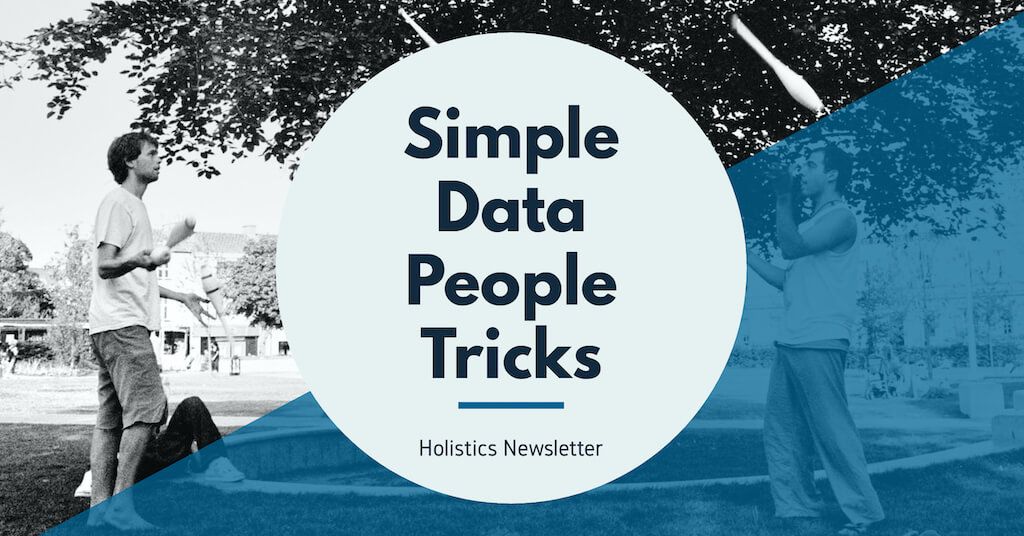Simple Data People Tricks
Simple data people tricks, a hierarchy of feature stores, and Shreyas Doshi on product metrics.

This newsletter was originally sent out on the 4th of March 2021. Sign up here if you'd like more like this.
Inner Join is Holistics's weekly business intelligence newsletter. This week: simple data people tricks, a hierarchy of feature stores, and Shreyas Doshi on product metrics.
Insights From Holistics
Simple Data People Tricks
As a business intelligence vendor, it's tempting for me to continually talk about the data space — its tools and vendors; it's ideological movements. But the practice of analytics isn't the same thing as tool adoption.
For instance: we may talk about some fancy new tool that's coming out (And we do! Sometimes! Especially if it represents a paradigm shift!) but it usually takes time to evaluate said tool, and more time still to implement it in your stack. Or ... we can talk about simple tricks you can do to increase the impact of your data team.
And sometimes the simple tricks are better.
For example, here's a trick that I learnt from Gordon Wong, the former VP of business intelligence at Hubspot: find an excuse to organize a data presentation for your entire company, perhaps at some milestone. The way Wong tells it, you'll want to accomplish two things: communicate some set of insights to a broader internal audience, and advertise your data team's capabilities, so you expand the set of possible questions other teams might ask.
Again, the idea of the technique is more important than the technique itself — it's likely that you can't easily organize a fancy in-person event during a global pandemic, after all. But the intention of the technique is that you'll want to let other operational people in your company know what your data team can do, so that you may serve them better. How you accomplish this might take some creativity.
There are other data people tricks, of course. For instance:
- Do you have a skills matrix? Some people are better at taking vague business requirements and firming them up for investigation. Others are not. Some people are good at creating understandable dashboards. Others are not. It might be a good idea to create a matrix of desirable skills for your data people, and then work to move everyone above a certain baseline.
- Understand your stakeholders's problems, and connect them to the data people who can solve them. This goes something like having lunch with the head of marketing, understanding her concerns, and then sending an email that says something like: "Hi Jennifer! Have you seen the cohort analysis that Matt did for product?" — with the tacit understanding that Matt is likely able to help her with better reports for her campaigns. You'll want to act as a connector across the org, which leads us to —
- Set up regular meetings with each department in your company, or find ways to immerse yourself in their problems. "Empathy," Wong says, "Empathy is ultimately what helps you to help them." Many operational leaders are too busy with their day-to-day to think about potential new input metrics; as a data person, you've likely got a perspective that they do not.
Insights From Elsewhere
A Hierarchy of Feature Stores — Features (and labels) are the inputs for machine learning models. You know — you have a bucket of cat pics, and you want to train a model to predict cat breeds. So you do a bunch of transformations on those cat pics before training — you turn them grayscale, you distort them, you flip them upside down, and so on. Presumably, after all that processing, you'll want to store these features for reuse somewhere. Eugene Yan has a pretty comprehensive overview of the current set of feature store tools — and his post is hot on the heels of the December 2020 release of AWS's SageMaker Feature Store.
This is a huge post; Yan brings some much-needed clarity to the space.
Shreyas Doshi on Choosing, Refining, and Tracking Product Metrics — Doshi is PM lead at Stripe, and this is a massive post that details all the possible product metrics that he checks. I found this bit in the middle particularly useful:
Some tactics I’ve found useful for using metrics:
1. Treat your metrics dashboard like a product.
2. Actually track its usage (meta!).
3. Set a Chrome pinned tab for the dash.
4. Review your pinned tab on set days (I do it every morning).
5. Set a weekly email report (people love emailed metrics).
Finally, Doshi argues that the six categories he introduces in the post prevents you from missing out on certain aspects of product instrumentation; you really want to think holistically (ahem) about user value and business value.
You Should Pick Your Org Chart When Looking at a (Data) Position — Randy Au with some good career advice for junior data people:
This last vector ("how much organizational bullshit can you handle?") tips the scales in my brain for what places I can recommend. Someone who is fresh out of school and hasn’t been exposed to organizational challenges has very low chances of succeeding if they’re thrown into a solo data scientist position without someone to help them learn that stuff, like a skilled manager. Without support, they’ll make mistakes, be unable to find support and allies, focus on the wrong work, and generally get demoralized.
Meanwhile, someone who’s really good at handling all the organizational stuff can go almost anywhere they want and stand a fighting chance of doing well. Even if their technical skills might be weaker than average, they can “play the game” enough to avoid nasty pitfalls.
The flip side of this, of course, is that if you're hiring your first data leader, you'll want to filter for those with a high tolerance for org bullshit.
Other News: Chartio gets acquired by Atlassian. Google BigQuery introduces a 'modern take' on Materialized Views. Snowflake external functions "will allow the possibility of building apps on top of the data warehouse!"
That's it for this week! If you enjoyed this newsletter, I'd be very appreciative if you forwarded it to a friend. And if you have any feedback for me, hit the reply button and shoot me an email — I'm always happy to hear from readers.
As always, I wish you a good week ahead,
Warmly,
Huy,
Co-founder, Holistics.
What's happening in the BI world?
Join 30k+ people to get insights from BI practitioners around the globe. In your inbox. Every week. Learn more
No spam, ever. We respect your email privacy. Unsubscribe anytime.

